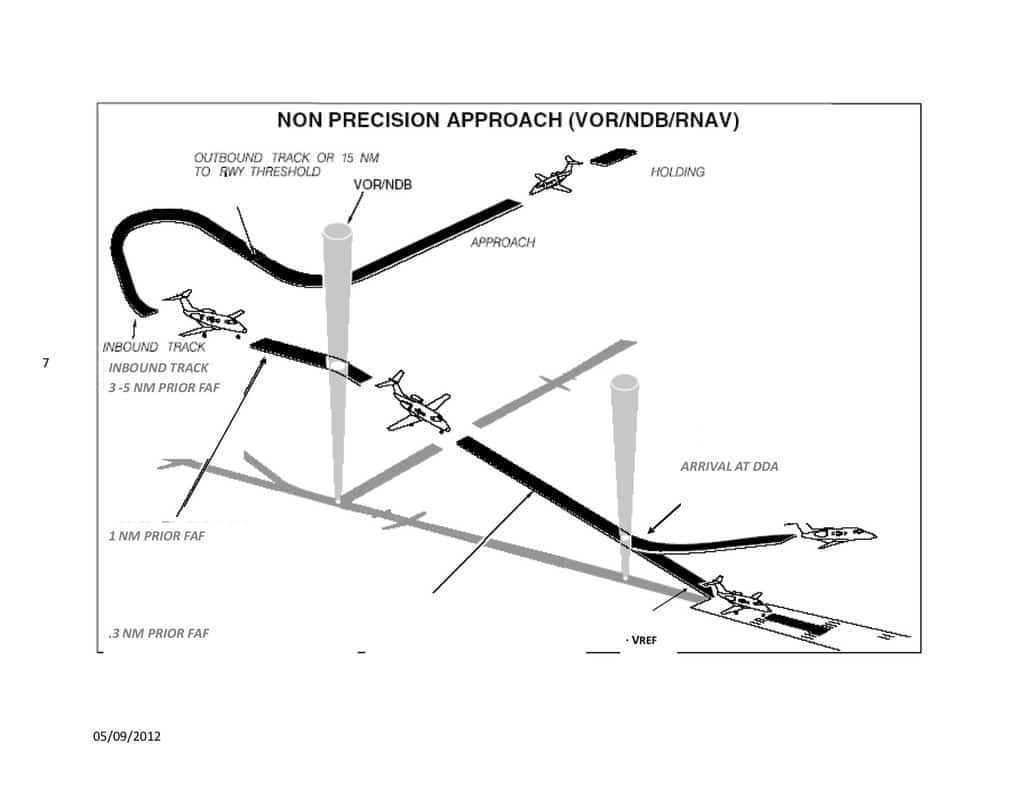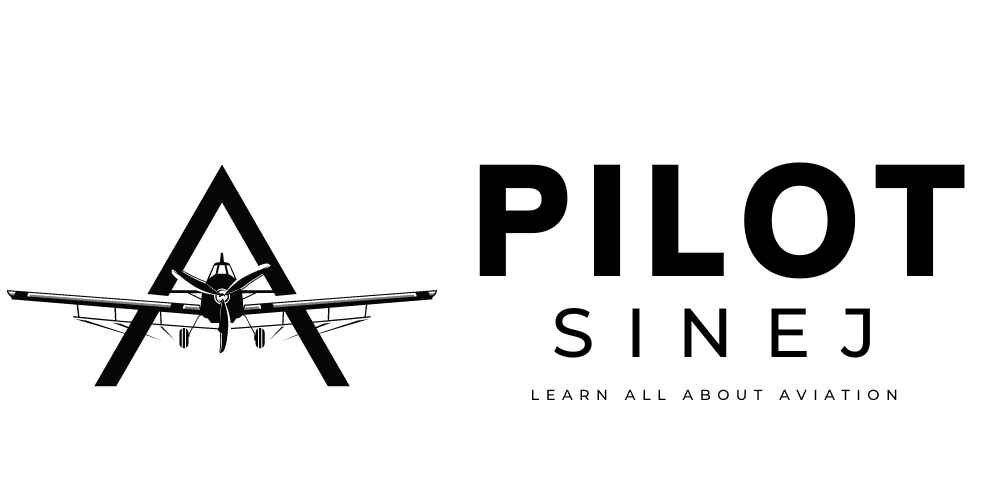The non-precision approach (NPA) is an instrument approach that does not provide vertical guidance like its precision counterparts.
Instead, NPAs rely on lateral guidance using navigational aids such as VOR and localizer signals.
During the final approach, pilots must follow the designated approach procedure to safely navigate to the runway, maintaining the required altitude and minimum descent altitude (MDA).
The initial approach fix (IAF) marks the beginning of the approach, where pilots can utilize LNAV for lateral navigation. In cases of missed approach, aircraft must follow the established procedure to safely exit the approach phase.
According to ICAO standards, NPAs are also classified as approaches without vertical guidance, simplifying the requirements for precision approach and landing operations compared to those with glide slope (GS) or glide path indications.
NPAs play a crucial role in aviation, especially in areas where surveillance radar is limited. They are essential for instrument flight rules (IFR) operations, allowing pilots to navigate safely even in adverse weather conditions.
The approach point is critical, as it indicates the transition from the en-route phase to the approach phase. Pilots must remain vigilant for deviation from the intended flight path, ensuring they maintain a safe trajectory towards the runway.
How does NPA differ from precision approaches?
Non precision approaches differ significantly from precision approaches in their operational capabilities.
A non-precision approach is an instrument approach that does not provide accurate vertical and lateral guidance, relying instead on basic navigation aids such as a non-directional beacon (NDB) or a radio beacon.
In contrast, a precision approach is considered a more advanced instrument approach, utilizing a landing system that offers precise vertical and lateral guidance, such as the localizer performance with vertical guidance (LPV) approach, which includes glidepath deviation information for enhanced safety during approach and landing which utilises this data.
In the context of 3D instrument approach operations, IFR approaches can be categorized into APV approaches and NDM approach types. The missed approach point is critical in both types, as it dictates the decision-making process for pilots.
While many modern aircraft are equipped to perform precision approaches, they can also execute non-precision approaches, which require pilots to rely more on visual cues and basic navigation techniques.
This distinction is vital for ensuring safe operations, especially at the approach end of runways where precision is paramount.
Types of NPAs Explained
There are various types of non-precision approaches that pilots may utilize during an instrument approach and landing. These approaches include ILS approaches with vertical guidance, but are also classified as non-precision approaches when they lack such guidance.
For instance, a VDF approach or an LLZ only approach relies on lateral navigation without vertical assistance. Instrument approach procedures often incorporate beacon systems for guidance, while RNAV approaches provide a more advanced method of navigation.
Common types of NPAs include:
- VOR Approach: Utilizes a VHF Omnidirectional Range (VOR) station to provide lateral guidance, helping pilots maintain a defined course to the runway.
- NDB Approach: Relies on a Non-Directional Beacon (NDB) to offer basic lateral navigation without the precision of more advanced systems.
- RNAV/GNSS Approach: Uses satellite-based navigation (e.g., GPS) to provide accurate lateral guidance, making it one of the most widely adopted and versatile NPA methods.
- Localizer-Only Approach: Employs the lateral component of an Instrument Landing System (ILS) to guide the aircraft to the runway but lacks vertical guidance.
- SDF/LDA Approach: Specialized localizer approaches, such as Simplified Directional Facility (SDF) or Localizer-Type Directional Aid (LDA), which provide lateral guidance and are often used when standard alignment with the runway is unavailable.
Each of these methods offers a structured way to descend safely to a Minimum Descent Altitude (MDA), ensuring obstacle clearance while maintaining situational awareness. The choice of approach depends on the available navigation aids at the airport and the capabilities of the aircraft and crew.
The ICAO Annex outlines the requirements established for precision approach and distinguishes them from NPA.
Additionally, surveillance radar approaches can be considered non-precision since they primarily focus on lateral navigation. Pilots are required to maintain a visual reference during these approaches, as they lack the vertical guidance found in precision approaches.
Approach charts are essential tools that provide necessary information for executing instrument approaches which utilise lateral navigation. Understanding the differences between RNAV approach and traditional NPA is crucial for safe and efficient landings in various weather conditions.

How to Execute a NPA
Executing a NPA requires pilots to have a solid understanding of various navigation systems. Annex 6 outlines the standards for approaches that utilise lateral and vertical guidance, but may not provide the precision of an ILS localizer.
For instance, a VOR approach may not be aligned with the runway, necessitating careful navigation. In contrast, GPS approaches can provide course deviation information, aiding pilots in maintaining the correct flight path.
Pilots need to be proficient in interpreting the guidance provided by these systems, even when they do not meet the criteria for a standard instrument approach. While precision approach radar offers enhanced accuracy, NPAs rely on using ground references and other navigational aids.
The landing which utilises lateral guidance is essential for ensuring safety during descent, and the safety knowledge contributed by thorough training is crucial for successful execution.
What are the steps involved in executing these approaches?
Executing a NPA involves several critical steps that ensure safe landing, particularly in commercial air transport. Initially, pilots must assess the instrument approach operations type to determine the appropriate procedure.
The approach is considered a precision approach when it utilizes both lateral and vertical guidance; however, NPAs typically utilise lateral guidance but do not provide vertical guidance. In this context, the ndb approach serves as a standard step-down approach, where automatic systems may be left engaged until reaching the minimum descent altitude.
During the approach, pilots must remain vigilant to avoid controlled flight into terrain, especially when the guidance but does not utilise vertical navigation is in play.
Furthermore, landing operations are also classified based on the guidance capabilities. For NPAs that meet the requirements established for lateral guidance, pilots can execute a safe landing, even if the systems may be left engaged throughout the approach.
Understanding these steps is crucial for maintaining flight safety and operational efficiency.
How can pilots ensure safety during an NPA?
During a an approach, pilots can ensure safety by maintaining situational awareness throughout the procedure. This involves continuously monitoring their altitude, position, and aircraft performance. By effectively communicating with air traffic control, pilots can receive real-time updates that enhance situational awareness.
Additionally, thorough pre-flight planning and adherence to established procedures are crucial for a safe NPA execution.
Regulations and Standards for NPAs
Regulations and standards for these approaches are essential for ensuring safe and efficient aircraft landings. These approaches provide guidance but do not meet the precision of instrument landing systems. Instead, they rely on various navigational aids to guide pilots during the landing phase.
The procedures are based on a navigation system that may include VOR or NDB, which help maintain the aircraft’s trajectory.
In many cases, they utilize lateral guidance that is similar to the ILS localizer, allowing pilots to align with the runway while still adhering to safety protocols established by aviation authorities.
What are the minimum requirements for conducting an NPAs?
The minimum requirements for conducting NPA include having a suitable approach procedure published and accessible to the pilot. Additionally, pilots must ensure that the minimum descent altitude (MDA) is established and that visibility conditions meet the specified minimums for the approach.
Lastly, the aircraft must be equipped with appropriate navigation instruments for safe execution.
What is the role of minimum descent altitude (MDA) in a NPA?
The minimum descent altitude (MDA) plays a crucial role in a NPA by establishing the lowest altitude to which an airplane can descend during the final approach phase.
Pilots must maintain this altitude until they can visually identify the runway environment.
Additionally, the MDA ensures safety by providing a buffer against terrain and obstacles, allowing pilots to execute a stable approach. If the runway is not visible at MDA, a missed approach procedure must be initiated to ensure safe navigation.

Training and Resources for NPAs
In today’s dynamic landscape, training and resources for NPA are crucial for fostering adaptability and innovation. Organizations must prioritize comprehensive training programs that equip employees with the skills to navigate uncertainty and make informed decisions.
Additionally, providing access to diverse resources, such as workshops, online courses, and collaborative platforms, can enhance learning experiences. By embracing non-precision methodologies, teams can develop creative solutions and improve problem-solving capabilities.
Ultimately, investing in training and resources for NPA empowers individuals and organizations to thrive in an ever-evolving environment.
Conclusion: The Importance of Understanding Non-Precision Approaches
NPAs play a crucial role in various fields, particularly in decision-making processes where traditional precision methods may fall short. Understanding NPAs allows individuals and organizations to navigate uncertainty and complexity more effectively.
By embracing flexibility and adapting to changing circumstances, NPAs provide valuable insights that can lead to innovative solutions.
Moreover, recognizing the significance of NPAs fosters a culture of collaboration and open-mindedness, encouraging diverse perspectives. This approach not only enhances problem-solving capabilities but also promotes resilience in the face of challenges.
Ultimately, a thorough understanding of NPAs empowers stakeholders to make informed decisions, balancing risk and opportunity in an increasingly complex world.
People also ask
What is considered a non-precision approach?
Is an RNAV approach precision or non-precision?
What are the three types of precision approaches?
- ILS (Instrument Landing System): Provides both lateral and vertical guidance.
- PAR (Precision Approach Radar): Guided by ground-based radar with precise lateral and vertical directions.
- GBAS (Ground-Based Augmentation System): A satellite-based system with ground station corrections offering precision similar to ILS.
